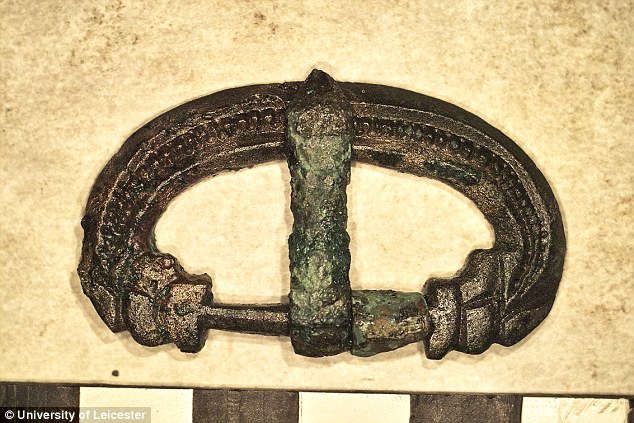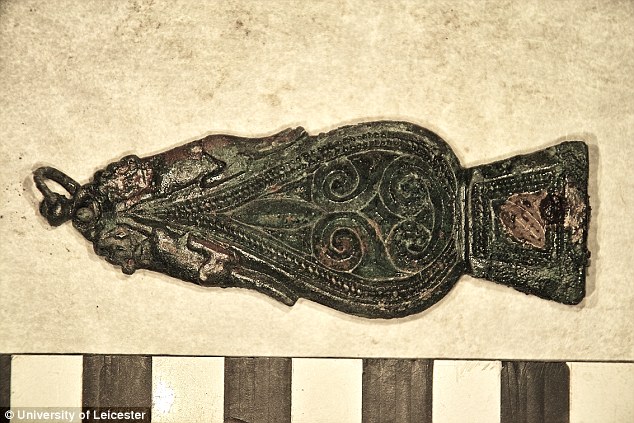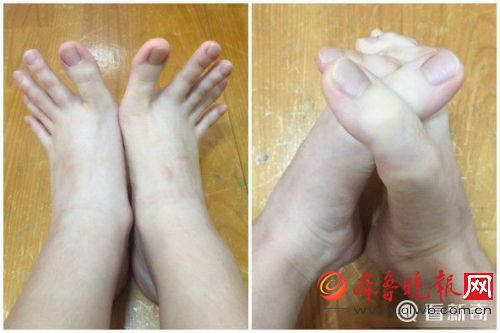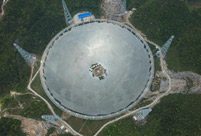

It is an elaborate belt any modern fashionista would be proud of.
Engraved with dolphins and dogs, in fact it belonged to a middle aged later Roman soldier.
Archaeologists found the rare evidence near an important Roman road in Leicester.

The bronze belt plate is cast in the so-called 'chip-carved' style and would have been riveted to a wide leather belt or girdle with a thinner securing strap running through the buckle and ending with the strap end.
While it gave up 83 skeletons, the University of Leicester team were stunned to find one wearing the elaborate belt around his waist, in rare evidence of Late Roman official buried in the city.
Archaeologists from University of Leicester Archaeological Services made the find at Western Road in Leicester's West End.
Amongst the 83 skeletons recorded by the team, one burial is proving to be very exciting.
The simple grave in question had been dug into mudstone on the west bank of the River Soar, to the south-west of the Roman town close to the important road known as the Fosse Way.

The grave of Skeleton 23, thought to be a Late Roman soldier or civil servant. The belt buckle was found next to the right hip (circled).
Buried in grave 23was the remains of a middle-aged man wearing an elaborately decorated belt in a style that would have been worn by a Late Roman soldier or civil servant during the second half of the 4th century or the early 5th century AD.
The find, which is rare in Britain, was positioned at the waist of the skeleton and comprises a belt buckle, belt plate and strap end.
The belt's owner was aged between 36 and 45 when he died, the researchers said.
He had survived poor health in childhood to lead a comparatively fit adult life but at some point he had fractured his left forearm; an injury that had healed well but left his wrist weakened.
This type of injury is known as a 'parry fracture' and is typically caused by raising the arm to ward off a blow or a falling object.
The man had also damaged muscles in his upper right arm and shoulder.

The belt buckle is decorated with dolphin heads.

The strap end is decorated with crouching dogs on either side of its tapered end.
'It is cast in the so-called 'chip-carved' style decorated with interlocking spirals and would have been riveted to a wide leather belt or girdle with a thinner securing strap running through the buckle and ending with the strap end.'
The buckle is decorated with dolphin heads and the strap end is decorated with crouching dogs on either side of its tapered end.
Parallels for this belt set have been found in other Late Roman cemeteries, for example in London, Dorchester on Thames and Winchester, and at the shore fort on the opposite side of the English Channel at Oudenburg in Belgium.
Research shows that these belts were worn across north-eastern France, Belgium, and along the eastern frontier of the Roman Empire, running along the Rivers Rhine and Danube, where soldiers were stationed.
There is some contemporary pictorial evidence to suggest that this type, specifically, was worn by members of the Late Roman military and civilian elite and that the belts were important symbols of authority.
The recent discovery at Western Road is the first occurrence of such a complex belt set in Roman Leicester.
The belt's owner was aged between 36 and 45 when he died.
He had survived poor health in childhood to lead a comparatively fit adult life but at some point he had fractured his left forearm; an injury that had healed well but left his wrist weakened.
This type of injury is known as a 'parry fracture' and is typically caused by raising the arm to ward off a blow or a falling object.
The man had also damaged muscles in his upper right arm and shoulder.
Such injuries could possibly be caused by over-use, overextending the muscles with movements such as throwing and lifting.
Whilst it is difficult to identify exactly what caused these injuries, they are consistent with those a soldier might suffer and reinforce the theory that this man was either a member of the late Roman army or, perhaps following retirement, became an important local civil servant.
 Who Will Fit The Chinese Roles In Game Of Thrones?
Who Will Fit The Chinese Roles In Game Of Thrones? China's Hubei Shennongjia added to World Heritage List
China's Hubei Shennongjia added to World Heritage List "Straddling bus" starts production in east China
"Straddling bus" starts production in east China Girl goes viral for finger-long toes
Girl goes viral for finger-long toes Five made-in-China hi-tech breakthroughs
Five made-in-China hi-tech breakthroughs HK-Zhuhai-Macao Bridge to open to traffic
HK-Zhuhai-Macao Bridge to open to traffic China opens its first combined transport service to Nepal
China opens its first combined transport service to Nepal Students take stylish bikini graduations photos
Students take stylish bikini graduations photos Charming dancing students pose for graduation photos
Charming dancing students pose for graduation photos Top 10 livable Chinese cities
Top 10 livable Chinese cities Top 20 hottest women in the world in 2014
Top 20 hottest women in the world in 2014 Top 10 hardest languages to learn
Top 10 hardest languages to learn China’s Top 10 Unique Bridges, Highways and Roads
China’s Top 10 Unique Bridges, Highways and Roads Barring Russia will tarnish Olympic spirit
Barring Russia will tarnish Olympic spirit Wukan disputes highlight conflict of interest at heart of rural development
Wukan disputes highlight conflict of interest at heart of rural development S.Korean companies in China say they’re not impacted by anti-missile system
S.Korean companies in China say they’re not impacted by anti-missile system Couples say dedication, not time, determines the strength of a marriage
Couples say dedication, not time, determines the strength of a marriageDay|Week